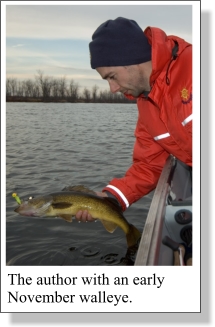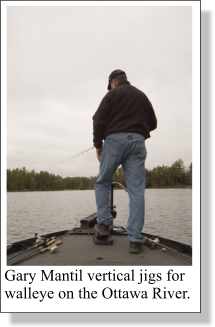|
Fall
River Walleye Tactics
By Tim Allard
 It was mid October and
I was river fishing for walleye. The shoreline trees still held some
leaves, but plenty had fallen over the last couple of weeks. I
bounced a jig off bottom and then felt a light tick. Setting the
hook, a good-sized walleye was soon in the net and one of many I
caught that day. It was mid October and
I was river fishing for walleye. The shoreline trees still held some
leaves, but plenty had fallen over the last couple of weeks. I
bounced a jig off bottom and then felt a light tick. Setting the
hook, a good-sized walleye was soon in the net and one of many I
caught that day.
Late September to
ice-up is prime time to river fish for walleye. Here's what you need
to know to take advantage of this predicable, seasonal bite.
Rivers Reliability
During Fall
Anglers fishing large, deep lakes are forced to deal with at least
one week of poor fishing after turnover. River enthusiasts don't
have this issue and water levels are often stable come fall. So
beyond inclement weather, there's never a bad time to be on a river
in autumn.
Walleye Movements
and Activity in Autumn
As summer ends, walleye begin to move towards their wintering spots
on rivers. They leave their shallow-water haunts, moving to
deep-water structures. What's better is walleye school-up on these
autumn areas, so once you find them you're likely to get into
several fish.
Although cold water
makes for less energetic fish, fall walleye are beautifully
proportioned. This is because they're feeding heavily, stocking up
their reserves for the rigors of winter and the upcoming spawn. As
walleye are still feeding it's rare for them to refuse an easy meal
dangled in front of their noses.
River Location
I've had success targeting walleyes relating to a variety of deep
structures. I find that 20 feet seems to be the magic depth where
walleye begin holding in autumn. Deep holes in river bends attract
walleye once cold water temperatures arrive. Steep breaks near
points are also good. An area where a tributary's outflow intersects
the first major, deep break or main river channel is another good
spot. Deep outwash areas near dams or large culverts can also be
good during the early stages of the fall. These structures are often
fairly large and easy to locate on a hydrographic, fishing map.
 Jigs: The Best Bait Jigs: The Best Bait
It's tough to beat a jig when fall fishing for walleye in rivers. I
find I have the best control with a jig than any other presentation
in moving water. Vertical jigging is an effective way to thoroughly
fish deep water with precision. Snags are one downside to jig
fishing in rivers, but loosing a few baits is part of the game when
fishing deep, moving water. Standard, round ball-head jigs work for
river fishing. You'll want to carry an assortment of jig head
weights, with ¼- ounce being the lightest.
Body Options for
Jigs
There are a variety of body options to use with jigs. If fish are
active you may be able to get away twister tails without live bait.
Scent-infused soft-body baits, like Berkley Gulp, help sweeten the
offering. Prime colours include: chartreuse, yellow, orange, white
pink, purple and smoke.
Of course, live minnows
make jigs even deadlier. You can tip jig bodies with minnows, or
fish a minnow alone. Experiment with different presentations and see
what catches fish to determine the day's best pattern.
To rig minnows alone,
follow this technique. Hook them through the lower lip, out the gill
plate, and then through the back. Although the rigging limits their
action, it saves bait when jigging in fast water and around snags.
Rods, Reels and Line
For basic vertical jigging in rivers I prefer spinning rods. You can
go with a basic medium-power, fast-action rod around 6'6". The past
several years I've been using a slightly shorter model. A sensitive
stick, it's a 6'2" G. Loomis walleye jigging rod. I find the shorter
length works well for this style of fishing, letting me work a jig
with extremely subtle moves. I match the rod with a Shimano Sahara
2500, spooled with either 20- or 30-pound super line. At the
business end, I use a uni-knot to tie on a three to four foot,
12-pound fluorocarbon leader.
Odds are there are a
few rivers within a reasonable drive from your house. With a
hydrographic map in hand, it's easy to identify potential deep water
areas likely to hold fish. Go with plenty of jigs and minnows and
you're sure to boat some good-sized, autumn 'eyes.
|